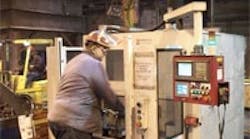As one of the company’s two machining centers, Farrar Corp.’s plant in Norwich, KS, offers comprehensive facilities that combine the services of a machine shop and ductile iron foundry to meet the needs of its customers.
Farrar specializes in producing ductile iron castings from 2 to 70 lb, in production runs from 100 to 100,000 lb.
Prior to last summer, Farrar had relied on hand grinding, as well as robotic grinding systems, but those methods had some disadvantages. According to foundry operations manager Richard Hicks, robotic and hand grinding was inefficient and undependable, forcing the group to seek out more cost-effective solutions. Human error and slow speed plagued hand grinding, and robotically ground parts often suffered from excessive flash.
Joe Farrar, president, visited a founddry that had Barinder grinders installed by Roberts Sinto Corp. as part of its operation. After observing the grinders at work, he dispatched teams from Farrar to other foundries that also use automated grinders. The reports came back in favor of the Barinder brand.
Innovative robotic part handling and unique grinding wheels reliably automate the removal of gates, burrs, and parting line fins on gray and ductile iron castings. Most castings can be quickly cleaned in a single set-up, traversing the same path that would be covered in a manual operation.
Additionally, the fast robotic cleaning action of the Barinder is enhanced by an optional second, smaller grinding wheel, making it possible to clean internal surfaces in areas that would be difficult to reach manually.
Because just one person can operate several machines, the streamlining of work has produced significant labor cost savings for Farrar. Operating the Barinder machine is easy to learn, allowing the operator to teach-program the machine quickly, and to automatically perform tasks that otherwise would be done manually.
After witnessing first-hand the successful performance of the Barinder in real-life situations, and taking into consideration all of the benefits that it had to offer, Farrar Corp. purchased two units last June, both of which were installed and operational within 24 hours. Farrar maintenance supervisor Mike Coons has glowing reviews for the additions, calling them an ‘absolute dream.’
“Since we installed the Barinder, we haven’t had any problems that weren’t operator-induced. I’d say it works as well as it was advertised, but that doesn’t even do it justice. It works far better than advertised, and we couldn’t be happier with it.”
“I’ve been in the foundry business for 13 years, and I’ve never experienced any machine like this,” Coons continued. “It started lowering manpower in the grinding room from the get-go.”
“We used to have significant downtime because the competitor’s auto-grinding machines just weren’t built to accommodate the output we expected of them,” said Farrar. “But, since the installation of the Barinder grinder, we’ve had zero downtime. And, we work these machines — hard.”
“Not only has the Barinder dramatically increased productivity,” he adds, “but the parts it produces are more consistent and the machine is more reliable.”









